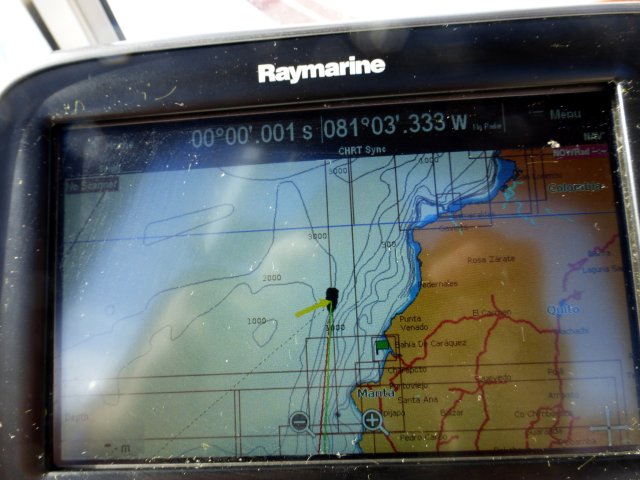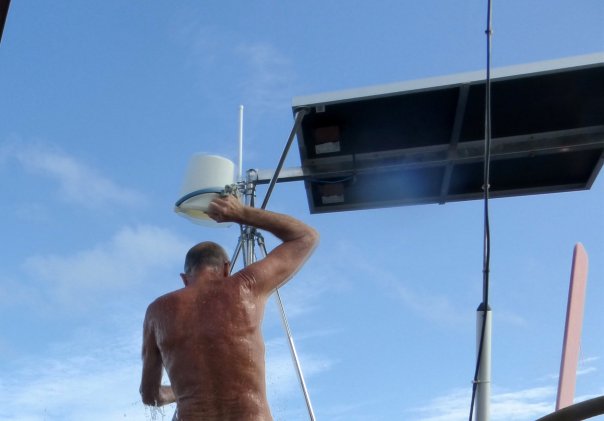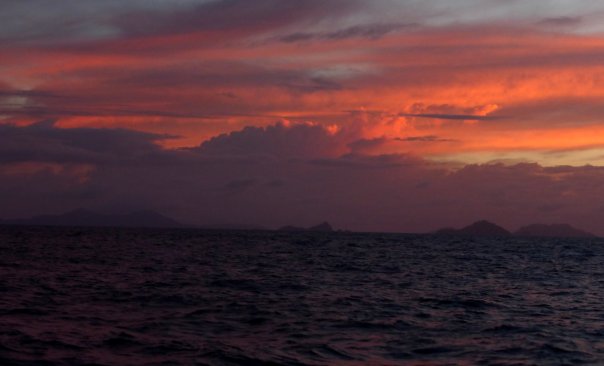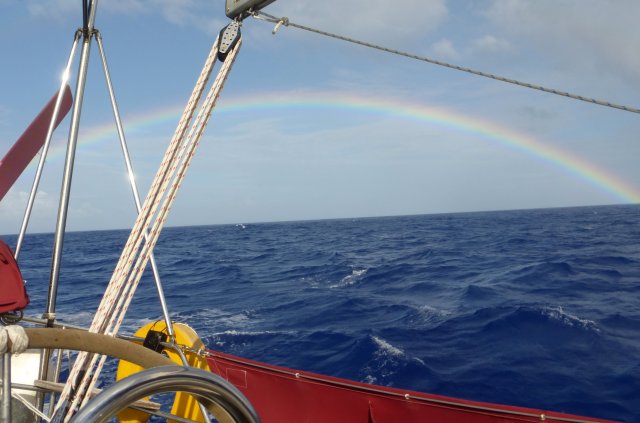Pacific Ocean
Introducing the Pacific
1st May to 7th June

With food lockers filled from the big busy thriving fruit and veg market of Panama City, and water tanks full, Henrietta and I left Balboa, Panama, on 2nd May and, after a night at the nearby island of Taboga (said to be popular but not then) sailed 4,160 miles to arrive at Mangareva, one of the Gambier Islands, 35 days and nights later. It was the first month of my life when I have not seen a single other human being. Though I’ve missed you, I don’t think I’ve gone mad without.
It wasn’t a blissfully easy month, not quite the South Seas sailing dream you may imagine. Frustratingly slow tacking south through doldrums and unexpected currents (and near Panama a lot of rubbish) to start with (sometimes less than 50 miles progress a day), then increasingly lively conditions sailing south-westwards, winds often strong and seas often rough, and then the final quirk of Pacific nature, almost becalmed for several days in the last few hundred miles. Nothing ever steady. The average wind strength, my book says is 14 knots; but that seemed to mean either well over 20 knots or less than 10 knots, not so much in between! And with rigging weakened, I was forever alert and far too anxious to enjoy a lot of sun-baked sailing leisure.

I don’t wish to sound facetious but there are three things you should know about sailing over the Pacific::
- It’s huge (see geography lesson below)
- There’s hardly anything there
- Its name is very misleading.
On any sailing boat on a long ocean trip, boaty bits sometimes fail, fatigue and anxiety levels rise and fall,and life isn’t always a doddle, whatever those romantic stories may say (though some of the time it still can be sublime, and most days are warm and sunny most of the time).
For me, the most anxious part of this trip was the discovery a week or so after leaving, that several strands of a main shroud had broken. (If you’re not a boaty person, that’s the wires that hold the mast up – so it’s potentially serious) – extra troubling as shroud was replaced in Falmouth less than a year ago. As a consequence, I’ve been a bit of a worry bag…. Made adjustments to try to limit the stress on the rigging and added stout ropes to try and save the mast should shroud fail – and sailing has been slower than it might otherwise have been. That’s probably dull to read about but it’s been a constant pre-occupation, a maritime obsession.
And otherwise, life aboard has had a typical steady series of mishaps: cockroaches in the cereal (a saga all of its own), rotting carrots, itchy beard, mouldy cheese and burnt lentils, holding tank leaking to bilge (poofy woofy!), bruised body and other stuff that’ll make me sound like an old whinge bag if I go on.
BUT, let’s be more cheery! Bird life, at least when south of Galapagos and for most of the next 3,000 miles, has been a joy – not lots of birds but occasional happy ballet of tern (?) or flawless aerobatics of a solitary shearwater over the ocean swell. And this fine handsome visiting bird which I don’t know (young albatross?).

 Flying fish with their scatty flashy sunlit flights skimming the wavetops. And in early days, little squid that landed on deck at night (flabergasting bad news for them but fascination for me). And the knowledge that you’re sailing one of the emptiest patches of water on the planet (Once away from the Ecuador coastline, I saw only two vessels early on (and then nothing for over three weeks) – a tanker whose watch officer told me even in his big ship he’d take another 16 days to reach Botany Bay, and a large French catamaran going fast to Tahiti for charter work. Oh, and a big fishing vessel who I passed uncomfortably close one night and who for reasons of his own wanted to be anonymous: no AIS and did not answer my call on VHF)
Flying fish with their scatty flashy sunlit flights skimming the wavetops. And in early days, little squid that landed on deck at night (flabergasting bad news for them but fascination for me). And the knowledge that you’re sailing one of the emptiest patches of water on the planet (Once away from the Ecuador coastline, I saw only two vessels early on (and then nothing for over three weeks) – a tanker whose watch officer told me even in his big ship he’d take another 16 days to reach Botany Bay, and a large French catamaran going fast to Tahiti for charter work. Oh, and a big fishing vessel who I passed uncomfortably close one night and who for reasons of his own wanted to be anonymous: no AIS and did not answer my call on VHF)
Sometimes on ocean voyages I ask myself what on earth I am doing. Instead of sleeping peacefully in a big solid static bed under a cosy duvet, dreaming sweetly till awaken by the happy tunes of a Devon dawn chorus, I find nights are disturbed with uneasy dream-filled restlessness and too often scrambling frantically off my berth in the middle of a dark windswept night, scrabbling for glasses and head torch, to reef a flogging sail as an icy rain squall soaks my back. And yet for now this is a preferable way of life. It’s enlightening and fulfilling, rewarding and in a way soul-soothing, a month without alcohol (bar the glass of wine that Neptune and I had on the equator), a simple diet, endless movement, the majesty of the ocean, time to read, and freckles on my bottom. The paradox of a personal comfort zone that’s not at all comfortable. The choices some of us are so lucky to have.
Other odds and ends……..Outside the normal routine for me was my first ocean swim, a dip in the middle of the ocean, something most of us never ever get round to. But, becalmed in the doldrums off South America one day, hundreds of miles from everywhere, totally alone, sails hanging limp and completely floppy with not a whisper of a feather-breath of breeze, and also overheated, perspiring and feeling grubby, I jumped in. My fears had been threefold: a. thoughts of how deep it was (and all those creepy ugly big-eyed suspicious super-deep-sea life forms coming to bite my toes), b. wind getting up and Henrietta sailing off without me, and c. wondering if a shark might come and gobble me up. It was the last of these that troubled me most. My imagination can be vivid, so I didn’t swim around for long. Felt better afterwards though.
(Photos below of crossing equator)

Since the places I may mention in the next few months will mean very little unless you have sailed here (or have a detailed atlas with you), I’ll give a quick geography lesson. It’s a lesson I gave myself a few weeks ago. Because, like most of us, my knowledge of patches of the world outide those I’ve visited is hopelessly limited.
I’d heard of places like Tahiti and Hawaii and Bora Bora and had stopped once in the Cook Islands on an aeroplane, and I’d been to New Zealand, but I couldn’t tell you precisely where they all were. (Forget Hawaii as it’s in the North Pacific and an American State and I’m not going there for now.)
The South Pacific is mainly empty. Apart from the Galapagos Islands and Easter Island, all the islands you’ve ever heard of are in the western half, and they are very sparsely spread out. So sparse that when Magellan sailed across nearly 500 years ago, as the first European to do so and with no chart to guide him and with only a very vague idea of how far he might have to go, he missed the lot, pitching up in the Philippines some five months after he’d started from South America. (As an aside I’ll add that poor Magellan was killed in the Philippines. And of the five ships and 237 men who had set out with him from Spain, only one ship and 18 souls survived, getting home three years after they’d left. Ocean sailing really was an almost suicidally hazardous business.) The Polynesians who’d sailed east across the Pacific much much more slowly 1,500 years before Magellan, and must have been patiently tacking into the prevailing winds, did discover and settle some of the islands. And Polynesians are today the main inhabitants of all the more easterly islands, though far fewer in number than they used to be.
The first group I’ll visit are collectively named French Polynesia. They include the Marquesas, the Tuamotus, Gambier Islands, and Society Islands. Here’s a map.



Yes, well, M has told you the factual stuff. As usual he’s done a lot of faffing about with this and that while I’ve got on with the hard work as best I can.
Have I told you what a hopeless case my skipper is when it comes to deciding where to go? In fact, he’s the ultimate disaster when it comes to making any decision whatsoever, forever weighing up pros and cons, changing his mind, and boring everyone to tears. Well, this Pacific trip was a classic, a true tale of human indecisiveness. When we left Panama, the ship’s papers ( the Zarpe) said we’d go to Ecuador – to a nice looking spot called Puerto Amistad, a few hundred miles down the South American coast, just south of the equator. So we headed that way, me thinking that’s where we’d go. Then, for goodness sake, when we got near and could see the coastline as a pale grey smudge on our left, M decided not to stop, muttering something about being late and slow, and needing to get a move on, and not needing more food. He’d already decided not to go to the Galapagos Islands. The authorities there charge extortionate amounts for visiting yachts and they’re super-zealous with bureaucracy and you’re limited to one or two anchorages, and in truth they don’t really want me – or you – unless you pay lots, preferably on an organised trip .
So there we are. M won’t stop in Ecuador mainland or the Galaps. We have to turn west and go over three thousand miles to some islands in the middle of this gigantic ocean (which just so you know, is not very pacific in temperament – quite the opposite with all manner of quirky and unpredictable behaviour – sometimes decidedly violent often docile).
Next decision for M is deciding which islands. There are so many to choose from. He’s got some books and after a few days’ reading, he’s ruled out Easter Island and Pitcairn (it’s a bit late in the year, poor anchorages and perhaps not able to land even if we got there). The choice is now between Gambier Islands and Marquesas. Marquesas, the more popular, about 800 miles north of Gambier, both in French Polynesia. Gambier, M thinks looks more his cup of tea. Hardly any visiting yachts, a perfect 60km coral reef surrounding a few mountain islands, with one larger inhabited island and several depopulated ones, friendly welcome and the chart shows a township with a cathedral. So that’s where we head for.
But, would you believe it, oh deary deary me, it’s hard going. Our course only 20 degrees more southerly than Marquesas, but uncomfortable and wet and noisy. We crash and stagger, and I know M is thinking of my weakened shroud. After only a day or two, and with at least three weeks to go, M changes his mind and we’re going to the Marquesas….for now anyway. ……that’s where most sailing boats go….supposedly a broad reach for 3,000 miles…………
Two days later, and I think this is ridiculous, M changes his muddled mind yet again….for now we’re heading to the Gambier Islands. As I write this, there are 2,227 miles to go, so plenty of time for more changes of mind…..
…Many days later, and after another wobble in M’s spinning mind when he reconsidered Pitcairn (just a few miles out of our way and a bit closer), we made it to the Gambier Islands.
It’s pouring with rain and not very hot; reminds us of soggy days in Cornwall – just seven boats here for company.

Fantastic blog and what a fascinating journal. I cannot believe my brother is doing this journey. I am speechless and very proud of him❤️⛵️
LikeLike